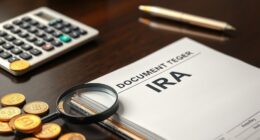To build an all-weather IRA portfolio, you should diversify across stocks, bonds, and stable fixed-income assets like CDs or TIPS. Keep a balanced mix, such as 60% stocks for growth and 30% bonds for stability, adjusting as you approach retirement. Focus on low-cost index funds and ETFs, and rebalance periodically to maintain your target allocations. If you want to master resilient strategies for any economic climate, you’ll find more insights below.
Key Takeaways
- Diversify across stocks, bonds, and fixed-income assets to balance growth and stability in any economic environment.
- Use low-cost index funds and ETFs to ensure broad market exposure and minimize expenses.
- Incorporate fixed income strategies like bond ladders and TIPS for consistent income and inflation protection.
- Regularly rebalance the portfolio to maintain target allocations adapting to changing market conditions.
- Start early and contribute consistently to maximize compound growth and mitigate market volatility risks.

Are you making the most of your IRA to secure a comfortable retirement? Building an all-weather IRA portfolio means preparing for any economic climate by balancing growth and stability. A key part of this strategy involves including alternative investments and focusing on tax optimization. These elements help you maximize returns while minimizing risks and expenses, guaranteeing your savings grow steadily over time. Tax considerations play a crucial role in shaping your IRA strategy, as choosing the right type and timing of contributions can significantly impact your overall retirement savings. Start early and contribute consistently to take full advantage of compound growth. Even small, regular contributions—say, $50 a month—can accumulate considerably by retirement. If you begin at age 25, contributing $5,000 annually with an average 7% return, you could have over $400,000 by age 55. Waiting just a decade reduces that amount, highlighting the importance of starting now. Consistent investing not only smooths out market volatility but also removes emotional decision-making by automating your contributions, which helps keep your strategy on track. Diversification across asset classes is essential to withstand any market storm. For your IRA, aim for a mix like 60% stocks, 30% bonds, and 10% fixed-rate products, such as IRA CDs. Stocks drive growth but come with higher volatility, while bonds provide income and stability—particularly important as you approach retirement. Including international assets diversifies your holdings further, reducing country-specific risks. Incorporating diversification strategies can help mitigate risks associated with market fluctuations and geopolitical events. Periodic rebalancing keeps your portfolio aligned with your risk tolerance and goals, locking in gains and avoiding overexposure to any one sector. Using low-cost broad index funds and ETFs is a smart move for cost-efficient diversification. They track major indices like the S&P 500 or total stock market, offering instant exposure at low fees. Large-cap index funds form the core of your equity holdings, while international and bond index funds add breadth. Paying attention to expense ratios ensures your returns aren’t eroded over time. Avoid over-concentrating in single stocks or sectors, which can increase idiosyncratic risk. Target date funds and asset allocation funds make managing your IRA easier. They automatically adjust your asset mix as you near retirement, shifting from growth-oriented assets to income and preservation. These “set and forget” options suit investors who prefer a hands-off approach, but it’s still wise to review their performance periodically to ensure they align with your evolving goals. Incorporating fixed income investments like bonds and CDs adds stability, especially as you near retirement. Bond ladders—buying bonds with staggered maturities—help manage interest rate risk and provide a steady income stream. High-quality bonds and inflation-protected securities like TIPS preserve your capital and hedge against rising prices. As your retirement nears, increasing your fixed income allocation shields your savings from market downturns. Balancing growth and income is crucial. Early on, higher equity exposure helps combat longevity risk and inflation. As you approach retirement, gradually shifting toward income-generating assets ensures your portfolio remains resilient, providing steady income and preserving your wealth through any economic climate.
Frequently Asked Questions
How Often Should I Rebalance My All-Weather IRA Portfolio?
You should rebalance your all-weather IRA portfolio about once or twice a year, depending on your investment goals and market fluctuations. Regular rebalancing guarantees your asset allocation stays aligned with your risk tolerance. Keep an eye on your portfolio’s performance, and make adjustments when your allocations drift by more than 5-10%. This approach helps you maintain a balanced risk profile and optimize long-term growth.
What Are the Risks of an All-Weather IRA Strategy?
Imagine sailing through choppy waters—that’s what market volatility can do to your portfolio. The risks include potential losses during downturns and liquidity risks if you need quick access to cash. While diversifying helps, unexpected market swings can still impact your investments. Staying informed and regularly reviewing your strategy can help you navigate these risks, ensuring you’re prepared for both calm seas and storms ahead.
Can I Customize the Portfolio to My Risk Tolerance?
Yes, you can customize your portfolio based on your risk tolerance. Start with a thorough risk assessment to understand your comfort level. Then, modify your asset allocation accordingly, increasing or decreasing exposure to stocks, bonds, or other assets. This personalized approach guarantees your all-weather IRA aligns with your financial goals and risk appetite, helping you stay resilient through economic fluctuations while maintaining confidence in your investment strategy.
How Does Inflation Impact an All-Weather IRA Portfolio?
Inflation can be a sneaky fox, eroding your returns if unprepared. It impacts your all-weather IRA portfolio by reducing purchasing power and influencing interest rates, which can affect bond and stock valuations. To combat this, you should incorporate inflation hedging strategies, like assets that tend to rise with inflation, such as commodities or TIPS. Staying vigilant helps smooth out the bumps inflation might cause, keeping your investment steady across economic shifts.
What Are the Tax Implications of This Strategy?
You should consider the tax implications of this strategy by focusing on tax considerations and tax-efficient investing. Contributions to your IRA may be tax-deductible, reducing your taxable income now, while earnings grow tax-deferred. Withdrawals in retirement are taxed as ordinary income. Using a diversified approach helps manage future tax liabilities. Always consult a financial advisor to optimize your strategy, ensuring it aligns with your long-term tax planning goals.
Conclusion
By diversifying your investments, balancing risk and reward, and staying adaptable, you build an IRA portfolio prepared for any economic climate. You embrace strategic planning, remain disciplined in your approach, and continuously review your assets. You prioritize resilience, focus on growth, and commit to long-term stability. With these principles guiding you, you guarantee your retirement savings are resilient, reliable, and ready to weather any storm that comes your way.









